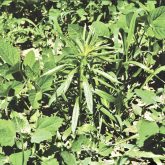As a concept, a long-term weed management plan may be nothing new. Even so, however, the reasons to adopt it are looking stronger than ever thanks to a combination of new technologies and a weed-resistance threat that keeps intensifying.
The concept certainly has merit, says Dr. Peter Sikkema, professor of weed science with the University of Guelph’s Ridgetown Campus.
Sikkema doubts many farmers actually have a five-year plan in place. It’s more likely their management plan rides along with their crop rotation, so if they’ve got a three-year rotation, they’ve effectively got a three-year weed management plan.
Read Also

Producers aren’t panicking over tariffs and trade threats
The influence of tariff and trade uncertainity on farm business decisions.
“You want to have a multi-year plan,” agrees Sikkema. “And there has to be flexibility in the system to adjust to current market conditions or other things that may impact that plan. But that doesn’t in any way negate the value of having a multi-year plan, and then being flexible and responsive as situations arise.”
Peter Johnson is also an advocate of long-term planning, although he takes it from a slightly different vantage point — with weed management falling in line with both crop plans and soil fertility plans, which should have a three-year frequency as well. It doesn’t make sense to apply fertilizer every year, he says, but to keep it routine as part of a three- or four- or five-year rotation — to suit the cropping plan — makes more sense. The same is true with weed management plans.
“A lot of growers are getting better at having that long-term plan, and glyphosate-resistant fleabane is pushing us again to make a longer-term plan,” says Johnson, now an independent agronomist. “Horse-tail forced me to have a long-term plan: I had field horsetail very bad in one field and I had wild carrot in another field that was very bad. So you come up with that three-year plan or whatever time frame that suits your cropping sequence, but you come up with that plan for the weed spectrum you have.”

The not-so-new reality of weed management in Eastern Canada is the rapid advance of Canada fleabane, common ragweed, giant ragweed and now waterhemp, all of which are resistant to eithr glyphosate or multiple modes of action.
The good news from Sikkema’s perspective is that although a species such as Canada fleabane can provide so many challenges, it is still manageable without relying on or abusing glyphosate. In a very brief sketch of a three-year crop plan, Sikkema confirmed it’s possible to use nine different modes of action in a three-year rotation, with none of them used twice.
In Sikkema’s model, managing Canada fleabane in Year One in corn would call for Frontier Marksman, made up of Group 15, 4 and 5 chemistries. In Year Two, a grower could use Optill in soybeans — a Group 14 and 2. And in the third year, the choice could be Infinity in wheat — with Group 27 and 6 chemistries. Glyphosate could be used as a cleanup — so that’s a Group 9. And just to keep weeds a bit more off balance, there’d be the option of using Roundup Ready corn or going with a Liberty Link hybrid, which opens the door to a Group 10.
Sikkema says such a lineup isn’t meant to show an ideal system, but it does demonstrate what’s possible.
“With a long-term plan such as that, you could have near-perfect control of glyphosate-resistant Canada fleabane, and that’s the driver weed in terms of glyphosate resistance in Ontario,” Sikkema says.
Of course, in a climate of low commodity prices, higher operating costs and the uncertainties at planting, there is the reality that farmers are governed by short-term economics and simplicity. And in recent years, the most profitable way to grow corn or soybeans has been to rely on Roundup Ready technology, despite the possibility of overrelying on glyphosate. Unfortunately, the results have been all too predictable.
“It’s not ‘if’ we get resistance to whatever herbicide we use, it’s ‘when,’” reminds Johnson, adding that there were some who originally said resistance would never develop in glyphosate, because of the way the molecule worked. “For any of us to think that can be true is pretty naive: all species want to survive and all species will find ways around whatever technology we throw at them.”
Besides, Sikkema says that the thinking behind his outline for the possibilities against fleabane also work on other weed challenges.
In other words, he says, mapping out a long-term weed management strategy and avoiding an overuse of glyphosate, to effectively manage weeds — including resistant species — is possible.
“Having been at this game for over 20 years now, it absolutely amazes me how rapidly a weed like glyphosate-resistant Canada fleabane came on the scene, how quickly it moved across the province and the density that we’re seeing in some fields,” Sikkema says.
Now, the same may be taking shape with glyphosate-resistant waterhemp. Sikkema is equally amazed with its density in some fields. It was confirmed late in 2014 in southwestern Lambton County and is now known to be flourishing in many other fields nearby. Late-season samples have been collected and will be analyzed during the winter.
In 2013, Ford Baldwin, a weed extension specialist from Arkansas, was at Bayer CropScience’s Rockwood Research Farm, to discuss the advance and overwhelming nature of Palmer amaranth. The weed made headlines in the mid-south region of the U.S. in 2010 for its spread and resistance to glyphosate, and was confirmed as far north as Illinois, Indiana and Michigan by 2013. Baldwin warned that as powerful a tool as glyphosate was, and as great a potential as Roundup Ready Xtend and Dow’s Enlist technologies offer, the ease with which growers adopted these technologies could be distressing. Glyphosate was a one-in-100-year discovery, he said, and after growers abuse Xtend and the Enlist systems, there’ll be nothing left. That has as much to do with the fact that there are few new herbicides in development, and haven’t been for more than 20 years.
We’re still a long ways from that scenario, yet Sikkema agrees there is reason for concern. There is a lot of upside in terms of weed management options in using dicamba in the Roundup Ready Xtend system or 2,4-D in Enlist corn (and pending soybeans).
“The challenge is, will farmers rely too much on the Group 4 chemistries (dicamba and 2,4-D)?” asks Sikkema. “If we get Roundup Ready Xtend or Enlist, they will be useful tools, and I think they’ll help farmers manage glyphosate-resistant weeds. But the concern is, will farmers overuse the technology?”
Yet despite the fact the pipeline of new herbicides is so empty, and amid concerns about the use of Xtend and Enlist technologies, all is not lost, says Johnson. Maybe there isn’t a “new glyphosate,” but the research cupboard is far from bare, a notion with which Sikkema also agrees. Where the herbicide door may be closed or even locked, there are windows of opportunity being raised, if not built and then opened.
“I think that technology will develop and could well be an RNAi technology,” says Johnson, referring to the ribonucleic acid interference pathway, now being researched by a variety of sources.
There are also studies into robotic methods of weed removal and the potential for biologicals or microbial biotech applications that hold a great deal of promise for a variety of uses, some including weed management. It may be slower than a chemical application, and its cost effectiveness is not yet to the point where commercial availability is feasible. But they are being developed.
“Having said that,” Johnson summarizes, “if we don’t manage everything we can to maintain the technology we have now for as long as possible, we deserve what we get.”
















